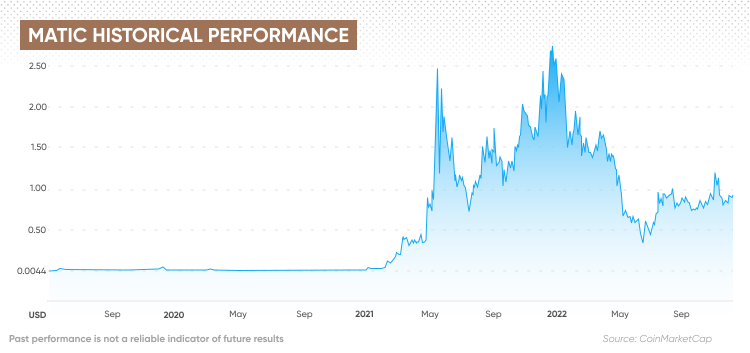
Defying the extreme turbulence in the cryptocurrency market Polygon (MATIC), a layer-2 scaling platform, reached a 7-day high of $0.9486 on 3 December.
As of 9 December, MATIC, the native token of Polygon, was trading at $0.9254, down more than 68% from its all-time high of $2.92, achieved on 27 December 2021.
MATIC live price chart
How will MATIC perform in the coming months, given the recent happenings surrounding Polygon? Who owns the most Polygon, and how will these developments affect them?
What is Polygon and how does it work?
Polygon, known initially as Matic Network, had a rebranding in February 2021. In late 2017, Jayanti Kanani, Sandeep Nailwal and Anurag Arjun formed Polygon, with Serbian engineer Mihalio Bjelic later joining as a co-founder.
Polygon is a protocol stack meant to address Ethereum’s (ETH) scalability problems. The Polygon network handles transactions on a second Ethereum-compatible blockchain to alleviate the network’s issues.
After processing transactions, Polygon returns them to the regular Ethereum network. This strategy reduces Ethereum’s network congestion, allowing Polygon to expedite transactions and reduce transaction costs to less than one cent.
In a nutshell, Polygon describes itself as a layer-2 network, functioning as an add-on layer to Ethereum that does not intend to alter the original blockchain layer. Like its geometric namesake, Polygon has many sides, forms and applications, providing a more straightforward structure for constructing linked networks.
Polygon aspires to assist Ethereum to grow in size, security, efficiency and utility and to encourage developers to create compelling decentralised applications (dApps) without worrying about network congestion.
After the 2021 rebranding, Polygon retained its MATIC cryptocurrency, the network’s underlying digital asset.
MATIC is an ERC-20 token that serves as the unit of settlement and payment amongst network participants. It is also utilised as a governance token, which allows token holders to influence the project’s development by submitting and voting on proposals. Additionally, users can stake their MATIC tokens to obtain staking rewards.
What is your sentiment on MATIC/USD?
Vote to see Traders sentiment!
MATIC tokenomics

MATIC, like the majority of cryptocurrencies, has a hard cap on its supply. A hard cap is the maximum amount of tokens that can be created on a blockchain to keep the token scarce. MATIC has a total supply of 10 billion tokens.
The token successfully completed its initial coin offering (ICO) on Binance Launchpad in April 2019 at a token price of $0.00263 and issued 19% (1.9 billion tokens) of its maximum supply, according to ICO Drops. It raised $5.6m in total.
Polygon conducted two further investment rounds shortly after this ICO. The first was a seed round in which they sold 2.09% of the total MATIC tokens for $0.00079 each. The second was a token sale for early supporters, in which 1.71% of MATIC tokens were sold for $.00233 each.
In February 2022, MATIC closed its most recent investment round, raising $450m headed by Sequoia Capital.
According to CoinMarketCap, MATIC has a circulating supply of 9 billion tokens and a market capitalisation of $8.08bn as of 9 December, making it the 10th-largest crypto project.
The complete breakdown of the MATIC token supply based on the initial allocation criteria from the first-mint is as follows:
|
Private sale (seed round + early supporters) |
3.8% |
|
Binance launchpad |
19% |
|
Team |
16% |
|
Advisors |
4% |
|
Staking rewards |
12% |
|
Foundation |
21.86% |
|
Ecosystem |
23.33% |
The remaining MATIC tokens not currently in circulation will be distributed over the following four years following a vesting schedule that will be concluded by 2025.
Who owns the most Polygon? MATIC whales analysis
According to CoinCarp, there were 5,52,236 Polygon holders as of 9 December, up from 5,05,200 wallet holders on 10 November, – a rise of 9.31%.
The top 10 and 100 holders dominated 66.29% and 85.1% of the MATIC supply, making it somewhat highly susceptible to pump-and-dump operations.
Who has the most Polygon tokens? Further analysis highlighted that Polygon was the biggest Polygon holder with approximately 5.08 billion tokens.
Among other top holders of Polygon, Binance (BNB), the world’s largest cryptocurrency exchange, was the second largest Polygon holder with 4.66% of the current circulating supply.
Kraken, another cryptocurrency exchange, held 0.75% of the supply, whereas Gemini and Voyager exchanges held 0.37% and 0.36%, respectively.
Apart from these exchanges, more wallets contained many MATIC tokens. Since crypto wallets are anonymous, the identities of these MATIC whales were hidden from the public.
Reportedly, Mark Cuban, a serial investor and entrepreneur, is one of the investors in Polygon, meaning he could be one of the large whales.
Polygon news and price drivers
On 6 December, Polygon announced a multi-year collaboration with LGND.io, a blockchain-based entertainment platform, and Warner Music Group (WMG) to create LGND Music, a a Web3 music marketplace where fans, producers, and listeners can purchase and trade music non-fungible tokens (NFTs).
LGND Music will be built on Polygon, according to the statement. As a result, the music NFT platform will benefit from cheaper gas costs and speedier transactions.
Over the past couple of weeks, Polygon has worked with various companies to develop its ecosystem. Polygon announced a partnership with Flipkart, an Indian e-commerce startup, on 2 December.
According to the official announcement, this collaboration seeks to establish a Blockchain eCommerce Centre of Excellence (CoE) in India to study and develop Web3 and metaverse commerce use cases to expedite Web3 adoption.
Polygon also integrated Graph, a decentralised platform for Web3 data indexing, onto its network. As a result of this breakthrough, Graph launched support for Polygon on 1 December, letting its customers leverage fully decentralised APIs to power their dApps.
The bottom line
Polygon (MATIC) is one of the few projects to accumulate a large crypto community because of its widespread adoption and practical applications. In addition, the network has established a benchmark for new layer-2 protocols in the cryptocurrency industry.
Polygon has fared well compared to most other cryptocurrencies amid the 2022 bear market. MATIC has been able to hold above crucial support levels and has now begun to rise again after an endless slide below.
Additionally, Polygon announced several significant collaborations in the spring and summer of 2022, including deals with Coca-Cola, Disney and Instagram, which helped the project’s expansion.
While knowing who owns the most Polygon tokens and other crucial facts is important for accessing the project’s tokenonomics and ownership concentration, you should always conduct your own due diligence. Look at the latest news, technical analysis, and a wide range of analysts’ opinions before making any trading decision.
Keep in mind that past performance is no guarantee of future returns. And never trade money that you cannot afford to lose.
FAQs
How many Polygon holders are there?
According to CoinCarp, there were 5,52,236 MATIC holders as of 9 December, up from 5,05,200 wallet holders on 10 November, a rise of 9.31%.
Who created Polygon?
Polygon was launched in late 2017 by Jayanti Kanani, Sandeep Nailwal, and Anurag Arjun, with Serbian engineer Mihalio Bjelic later joining as a co-founder.
Is Polygon legit?
Yes, Polygon is a legitimate business. Polygon seeks to make Ethereum-based dApps faster and more efficient for interacting with other blockchain platforms and enabling diverse blockchains to exchange information and value more readily.
Related reading
Rate this article




